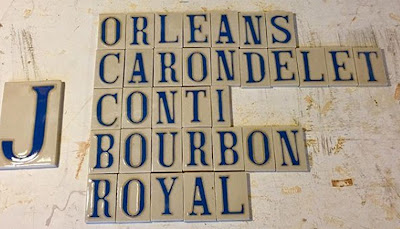A Covington resident for many years, Nicholas Hasslock fine-tuned his artistic skills and knowledge of ceramics to create authentic street corner letter tiles for the City of New Orleans. Hasslock, son of Tika and Steve Hasslock of Hasslock Studios,
grew up surrounded by artists from throughout the Covington area. That kind of upbringing helped provide him the skills to carry on an important New
Orleans tradition into the future.
While working the booth of
Hasslock Studios at Jazz Fest 2006, Nicholas was approached by a city
architect who was at a loss to find replacement tiles for the sidewalks.
The architect inquired whether Nicholas knew of anyone who could make
the ceramic lettered tiles that spell out the names of the streets on
nearly every corner in New Orleans. After not being able to refer him to
anyone, Nicholas suggested himself and that he would be honored to give
it a shot. Close to a year later, local contractors, Boh Bros.,
contacted and commissioned Nicholas for the job.
Over the next
two years at his studio in the Marigny, Nicholas worked on perfecting
the recipe for vitrification, the process by which clay becomes
non-porous and glass-like. It was one tough and necessary challenge to
give these tiles the integrity to withstand the wear and weather of the
heavily used sidewalks. The new tiles are the only traditionally
accurate replacement tiles that equally match the durability and color.
Matching the
exact colors of the original tiles was a key factor, something that took
an artist’s eye. “You just can’t pull any color off the shelf and use
it,” he says. The original tiles were made in Alhambra, Spain and
installed around the 1920's.
While working
with the historic letter tiles has a low-tech aspect, at the same time
he used modern computers in the design process, and actual production
required an understanding of the properties of ceramics and engineering
as well as chemistry. The process for making the
tiles is described as “magnetic soup that looks like gray pancake
batter.”
The production procedure is quite complicated. “There’s a
lot of stuff going on that you can’t see when you’re making the tiles,
but everything has to be right, or it gets brittle,” he explained. “I sort
of feel like an engineer during the process.” It also calls upon a lot
of artistic diligence and the ability to follow an exacting recipe.
His efforts to re-create the
“genuine” letter tiles paid off, and once he fine-tuned the
process, he branched out to produce tiles in other colors, fonts,
styles or with custom images.His tiles filled a specific community need, so he was not only a poet and an artist, but he also became a ceramics engineer with his own company, the New Orleans Tile Company.
He grew up attending Covington Elementary, Pine View Middle School, and Pitcher Junior High and graduated from Mandeville High, remembering many of the teachers and principals who helped him along the way. Associating with the St. Tammany art scene also helped focus his career ambitions.
Shown are some of the tiles plaques he made for the Covington Heritage Foundation home recognition program.
Those in the School System who had the most positive impact on him were his third grade teacher Ms. Julie Fontan, Principal William Brady at Covington Elementary, Principal Cynthia Russell at Pine View, Mr. Chris Blackwell, the science and biology teacher at Pitcher Junior High. “And I’m pretty sure none of my teachers have forgotten me,” he says. It was the science classes he liked most of all during his public school education.
He also takes time for community service projects, such as the Hurricane Katrina Memorial and Mural in New Orleans, another
example of his artistry and community volunteerism. As an artist, he liked making a statement the Katrina memorial wall, which is located on the front of the Saratoga Building at the corner of Loyola Avenue and Common Street in downtown New Orleans. It features 18 columns of names remembering those from New Orleans who died in Hurricane Katrina.
He worked on the project with deep respect for what it represented. As a result, lining the names up and making sure the letters were properly etched was important to him. “This is literally done in stone, so it has to be right,” he said. “It took me six weeks to get the first three columns of names done.” He worked on the project many times through the night, when it was cooler, with less sun glare, and fewer distractions.
His motto has pretty much been, “I don’t have to save the world. I just do the best I can, and try to be an example,” he said.
While he learned the basics of art from his parents, it was junior high science classes that gave him the edge to making that art come to life in tangible, and commercially-viable ways. His art and business studio located in the Marigny section of New Orleans gave him a window to the world.
“The nearby coffee shop has been a great place to learn,” he said.
“You find people there you want to be like, and people you don’t want to be like.” In his neighborhood in New Orleans, there are tons of contrasting viewpoints as well. “It’s huge, beautifully chaotic, and everyone’s allowed to be themselves,” he said. Such a parade of personalities has made him come to better appreciate the quieter lifestyles found back in St. Tammany.
His advice to up and coming young artists is to follow their feelings and be on the lookout for inspiration from wherever it might come. “I’m happy to be able to do what I’ve done,” Hasslock said, proving his own real-life example of how art and business can be successfully blended.
See also:
Nick Hasslock on Instagram




